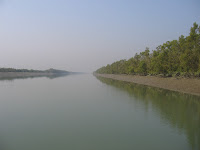World Heritage Site The Mangrove Forest in Bangladesh

 The Sundarbans (meaning ‘beautiful forest’ in Bengali language), the largest single area of tidal mangrove forest in the world, lies in the natural delta of the Ganges, the Brahmaputra and the Meghna. Although it is shared by both India and Bangladesh, 60% of its total area are in Bangladesh. The Sundarbans is about 6200 square kilometers in area and accounts for slightly less than 5% of total land area of Bangladesh. In 1997, UNESCO listed the Bangladesh part of the mangrove forest as ‘The Sundarbans’. Its beauty lies in its unique natural surroundings. Thousands of tortuous streams, creeks, rivers and estuaries have enhanced its charm. The Sundarbans is situated at the southwest region of Bangladesh in the districts of Bagerhat, Khuna and Satkhira. The name of Sundarbans originates from its major tree, Sundari, which is found in abundance in this forest. Some say, its name comes from Samudraban (forest in the sea).
The Sundarbans (meaning ‘beautiful forest’ in Bengali language), the largest single area of tidal mangrove forest in the world, lies in the natural delta of the Ganges, the Brahmaputra and the Meghna. Although it is shared by both India and Bangladesh, 60% of its total area are in Bangladesh. The Sundarbans is about 6200 square kilometers in area and accounts for slightly less than 5% of total land area of Bangladesh. In 1997, UNESCO listed the Bangladesh part of the mangrove forest as ‘The Sundarbans’. Its beauty lies in its unique natural surroundings. Thousands of tortuous streams, creeks, rivers and estuaries have enhanced its charm. The Sundarbans is situated at the southwest region of Bangladesh in the districts of Bagerhat, Khuna and Satkhira. The name of Sundarbans originates from its major tree, Sundari, which is found in abundance in this forest. Some say, its name comes from Samudraban (forest in the sea).The Sundarbans (Bengali: সুন্দরবন, Shoondorbôn) is the largest single block of tidal halophytic mangrove forest in the world. The Sunderbans is a UNESCO World Heritage Site covering parts of Bangladesh and India.

 Two-third of the Sundarbans is in Bangladesh while rest one-third is in India. The Sundarbans National Park is a National Park, Tiger Reserve, and a Biosphere Reserve located in the Sundarbans delta in the Indian state of West Bengal. Sundarbans South, East and West are three protected forests in Bangladesh. This region is densely covered by mangrove forests, and is one of the largest reserves for the Bengal tiger.
Two-third of the Sundarbans is in Bangladesh while rest one-third is in India. The Sundarbans National Park is a National Park, Tiger Reserve, and a Biosphere Reserve located in the Sundarbans delta in the Indian state of West Bengal. Sundarbans South, East and West are three protected forests in Bangladesh. This region is densely covered by mangrove forests, and is one of the largest reserves for the Bengal tiger.
 The name Sundarban can be literally translated as "beautiful forest" in the Bengali language (Shundor, "beautiful" and bon, "forest"). The name may have been derived from the Sundari trees that are found in Sundarbans in large numbers. Alternatively, it has been proposed that the name is a corruption of Samudraban Shomudrobôn "Sea Forest") or Chandra-bandhe (name of a primitive tribe). However, the generally accepted view is the one associated with Sundari trees.
The name Sundarban can be literally translated as "beautiful forest" in the Bengali language (Shundor, "beautiful" and bon, "forest"). The name may have been derived from the Sundari trees that are found in Sundarbans in large numbers. Alternatively, it has been proposed that the name is a corruption of Samudraban Shomudrobôn "Sea Forest") or Chandra-bandhe (name of a primitive tribe). However, the generally accepted view is the one associated with Sundari trees. Sundarbans Mangroves

 The Sundarbans Mangroves ecoregion on the coast forms the seaward fringe of the delta and is the world's largest mangrove ecosystem, with 20,400 square kilometers (7,900 sq mi) of area covered. The dominant mangrove species Heritiera fomes is locally known as sundri or sundari. Mangrove forests are not home to a great variety of plants. They have a thick canopy, and the undergrowth is mostly seedlings of the mangrove trees. Besides the sundari, other species that make up the forest includeAvicennia spp., , Xylocarpus mekongensis, Xylocarpus granatum, Sonneratia apetala, Bruguiera gymnorrhiza, Cereops decandra, Aegiceras coriculatum, Rhizophora mucronata, and Nypa fruticans palms.
The Sundarbans Mangroves ecoregion on the coast forms the seaward fringe of the delta and is the world's largest mangrove ecosystem, with 20,400 square kilometers (7,900 sq mi) of area covered. The dominant mangrove species Heritiera fomes is locally known as sundri or sundari. Mangrove forests are not home to a great variety of plants. They have a thick canopy, and the undergrowth is mostly seedlings of the mangrove trees. Besides the sundari, other species that make up the forest includeAvicennia spp., , Xylocarpus mekongensis, Xylocarpus granatum, Sonneratia apetala, Bruguiera gymnorrhiza, Cereops decandra, Aegiceras coriculatum, Rhizophora mucronata, and Nypa fruticans palms.
No comments:
Post a Comment